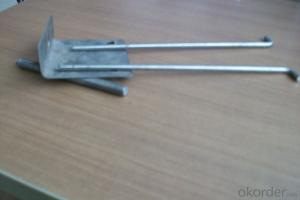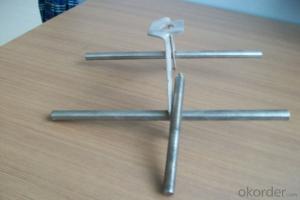Ceramic Fiber Module Refractory Anchor Product
- Loading Port:
- Qingdao
- Payment Terms:
- TT OR LC
- Min Order Qty:
- 1000 set
- Supply Capability:
- 500 set/month
OKorder Service Pledge
OKorder Financial Service
You Might Also Like
Material: SS310,SS304
Ingredient: 1Cr18Ni9Ti, Cr25Ni20
Working temperature 1260/1400 °C
For installation of ceramic fibre modules and block
U-form penetration nail
Instant card, rotation card
penetration rod
screw, nut
v-form rame
angle iron anchor
butterfly anchor
diamond anchor
hole suspending anchor, corner, anchor,etc
Wide temperature range,from800C to 1400C
Various shapes
Reasonable structure
Firm, reliable anchor
Install easily and quickly
Type | Anchor Products | |
Classification Temp.(°C) | 1260 | 1400 |
Name/Type | U-form penetration nail, Instant card, rotation card, penetration rod, screw, nut v-form rame, angle iron anchor, butterfly anchor, diamond anchor, hole suspending anchor, corner, anchor,etc | |
Textures | 304S Series | 310S Series |
Working Temp. (°C) | 1260 | 1430 |
Size | The anchor can be designed according to the application and the size of modules. | |
Packing | Carton | |
Technical Criteria | 1Cr18Ni9Ti | Cr25Ni20 |
- Q:Can stainless steel wire be coated or painted?
- Stainless steel wire has the capability to be coated or painted. Coating or painting stainless steel wire serves several purposes, including enhancing its appearance, offering extra protection against corrosion, and enhancing visibility or durability. It is crucial to consider that the coating or paint chosen must be suitable for stainless steel to guarantee proper adhesion and long-lasting results. Moreover, before applying any coating or paint, it is essential to thoroughly clean and prepare the stainless steel wire to ensure a successful and enduring finish.
- Q:What's the difference between stainless steel screws and galvanized screws? Why are galvanized screws good?
- 3. Good reliability: the combination of zinc coating and steel is metallurgical bonding and becomes a part of the steel surface. Therefore, the durability of the coating is more reliable;4, coating toughness: zinc coating forming a special metallurgical structure, this structure can bear in transit and use mechanical damage;
- Q:Is stainless steel wire suitable for wire spooling?
- Indeed, wire spooling can be accomplished using stainless steel wire. Renowned for its robustness, longevity, and ability to withstand corrosion, stainless steel wire is an exceptional option for an array of applications, wire spooling included. Its effortless winding and unwinding from a spool without the risk of kinks or breakage guarantee seamless and efficient operation. Moreover, its corrosion resistance ensures rust-free storage and prolonged utilization. Given its dependability and superior performance, stainless steel wire finds widespread use across industries like manufacturing, construction, and electronics.
- Q:What are the different types of stainless steel wire braiding techniques?
- There are several different types of stainless steel wire braiding techniques used in various industries. Some of the commonly employed techniques are: 1. Standard Braiding: This technique involves interweaving multiple stainless steel wires in a diagonal pattern, creating a flexible and strong braided structure. It is widely used in applications where high strength and flexibility are required, such as in hoses, cables, and electrical wiring. 2. Flat Braiding: In this technique, the stainless steel wires are braided in a flat and parallel configuration. This type of braiding provides excellent coverage and protection while maintaining flexibility. Flat braiding is commonly used in applications where a smooth and even surface is desired, such as in automotive wiring harnesses. 3. Diamond Braiding: As the name suggests, diamond braiding involves interweaving stainless steel wires in a diamond-shaped pattern. This technique offers enhanced strength and durability, making it suitable for high-pressure applications like hydraulic hoses and industrial machinery. 4. Square Braiding: Square braiding is a technique where the stainless steel wires are braided in a square or rectangular pattern. This type of braiding provides high coverage and resistance to abrasion, making it ideal for heavy-duty applications, such as in mining equipment and oilfield machinery. 5. Knitted Braiding: Knitted braiding involves intertwining stainless steel wires in a knitted pattern, similar to a fabric. This technique offers flexibility, stretchability, and excellent coverage, making it suitable for applications like expansion joints, bellows, and flexible connectors. 6. Overbraiding: Overbraiding is a technique where a layer of stainless steel wire is braided over an underlying structure or material. It provides additional protection, strength, and aesthetic appeal. Overbraiding is commonly used in applications like hoses, cables, and tubing to enhance their structural integrity and resistance to external forces. These are just a few examples of the different types of stainless steel wire braiding techniques. The choice of technique depends on the specific requirements of the application, such as desired strength, flexibility, coverage, and resistance to various environmental factors.
- Q:How is stainless steel wire different from galvanized wire?
- Stainless steel wire and galvanized wire are two distinct wire types, each possessing unique properties and characteristics. The dissimilarities between them can be found in their composition, corrosion resistance, and applications. Regarding composition, stainless steel wire consists of a steel alloy, chromium, and sometimes additional elements like nickel or molybdenum. This composition grants stainless steel wire exceptional strength, durability, and resistance against corrosion. Conversely, galvanized wire is composed of carbon steel wire coated with a layer of zinc. This zinc coating shields galvanized wire from rust and corrosion. In terms of corrosion resistance, stainless steel wire exhibits high resistance, rendering it suitable for various outdoor applications and harsh environments. It can withstand exposure to moisture, chemicals, and extreme temperatures without compromising its integrity. On the other hand, galvanized wire, though offering some corrosion resistance due to its zinc coating, is not as resilient as stainless steel wire. Over time, the zinc coating may wear off, leaving the underlying steel susceptible to rust and corrosion. Concerning applications, stainless steel wire finds common usage in industries such as construction, marine, automotive, and aerospace. Its superior corrosion resistance and strength make it ideal for applications requiring high durability, such as fencing, springs, cables, and wires utilized in surgical instruments or food processing equipment. Conversely, galvanized wire is often employed in applications where corrosion resistance is not the primary concern. It is commonly used in wire mesh, binding or tying material, or in the construction of fences and cages. To summarize, stainless steel wire and galvanized wire differ significantly in terms of composition, corrosion resistance, and applications. While stainless steel wire is renowned for its exceptional strength and resistance against corrosion, galvanized wire offers some corrosion resistance but is not as durable or long-lasting as stainless steel wire. The choice between these two wire types depends on the specific requirements of the intended application.
- Q:Where are the stainless steel screws?
- The key is to consider the use and the price. Stainless steel screws are more expensive.
- Q:Is stainless steel wire suitable for wire bending?
- Yes, stainless steel wire is suitable for wire bending. Stainless steel is a strong and durable material that maintains its shape well. It is commonly used in various applications that require wire bending, such as jewelry making, sculpture, and industrial manufacturing. Stainless steel wire can be easily manipulated and bent into different shapes without breaking or losing its structural integrity. Additionally, stainless steel is resistant to corrosion and rust, making it a reliable choice for wire bending projects that may be exposed to moisture or harsh environments.
- Q:How can make a fine stainless steel wire is not strong magnets attract?
- After chemical treatment, you can do it after removing the magnetism.
- Q:Can stainless steel wire be used for filtration?
- Yes, stainless steel wire can be used for filtration. It is commonly utilized in various filtration systems due to its durability, resistance to corrosion, and high strength. Stainless steel wire can effectively remove contaminants and impurities from liquids or gases, making it suitable for applications in industries such as water treatment, oil and gas, pharmaceuticals, and many others.
- Q:Is stainless steel wire suitable for wire rope connectors?
- Yes, stainless steel wire is suitable for wire rope connectors. Stainless steel is known for its corrosion resistance, making it a reliable choice for outdoor and marine applications where the wire rope may be exposed to moisture and other harsh elements. Additionally, stainless steel wire has high tensile strength, allowing it to withstand heavy loads and provide secure connections. It is also durable and long-lasting, ensuring the wire rope connectors will maintain their integrity over time.
1. Manufacturer Overview |
|
|---|---|
| Location | |
| Year Established | |
| Annual Output Value | |
| Main Markets | |
| Company Certifications | |
2. Manufacturer Certificates |
|
|---|---|
| a) Certification Name | |
| Range | |
| Reference | |
| Validity Period | |
3. Manufacturer Capability |
|
|---|---|
| a)Trade Capacity | |
| Nearest Port | |
| Export Percentage | |
| No.of Employees in Trade Department | |
| Language Spoken: | |
| b)Factory Information | |
| Factory Size: | |
| No. of Production Lines | |
| Contract Manufacturing | |
| Product Price Range | |
Send your message to us
Ceramic Fiber Module Refractory Anchor Product
- Loading Port:
- Qingdao
- Payment Terms:
- TT OR LC
- Min Order Qty:
- 1000 set
- Supply Capability:
- 500 set/month
OKorder Service Pledge
OKorder Financial Service
Similar products
New products
Hot products
Related keywords




























